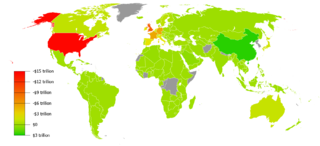Self-fulfilling currency crisis
General concept
Self-fulfilling currency crisis lies in the center of the 2nd generation currency crisis theory. First proposed by Obstfeld, [1] the Self-fulfilling mechanism is constructed as a complement of 1st generation theory. In the 1st generation theory [2] a country's currency will be attacked by speculators only if fundamental inconsistency exists in domestic policies, typically inflationary budget deficits and fixed exchange rate. Obstfeld etc. provided another way to analyze the happening of currency crisis focusing effect of self-confirming of pessimism.
Instead of blindly adhering to fixed exchange rate until running out of its foreign reserve, in the self-fulfilling model the government will abandon pegged exchange rate when it is optimal. The possible benefits from maintaining a fixed exchange rate include the following: facilitating international trade and international investment, using fixed exchange rate as nominal anchor to prevent inflation, gaining good reputation of policy consistency. Meanwhile, the government usually needs to raise the domestic short-term interest rate to prevent speculative attacks, and the associated cost from raising interest rate includes higher deficit pressure, harming financial stability and higher unemployment rate and economic recession consequently. Therefore, conflicts arise between the government's incentives, or between internal balance and external balance. If people believe that the currency will depreciate in the future, by uncovered interest parity, the short-term interest rate will rise as a result, which makes defending fixed exchange rate more costly. When the cost is sufficiently high, fixed exchange rate is abandoned and currency crisis happens.
A theoretical framework
The general idea of self-fulfilling currency crisis can be illustrated in the following example modified from Obstfeld (1996), [3] which explains why pegged exchange rates that could be sustained in the absence of speculative attack can be overthrown by market pessimism among investors.
This prototype model contains three agents, a government and two investors. The government will buy or sell its foreign reserves to fix its currency's exchange rate, while the two investors hold domestic currency and can continue holding it or sell it for foreign currency. In reality, there should be many money holders, but this simplified model captures key features of most cases.

The government commits a finite stock of reserves to defend the currency peg, which defines the payoffs in this one-shot noncooperative game that the two investors play. Suppose the government's committed reserves are 10, and each trader has domestic currency resources of 6 which can be sold in the market for foreign reserves ('sell'), or held ('hold'). To sell the domestic money, traders bear a cost of 1. Neither trader alone can run out the government's reserves, but both can if they sell together. The payoff matrix of the two traders is given below. There are two Nash equilibria in this game. In the first (good) equilibrium, if neither trader believes the other will attack, the Nash equilibrium in the northwest corner is realized and the fixed exchange rate survives. But if both traders expect the other will attack and chooses to attack as well, the currency peg falls, which results in the other (bad) Nash equilibrium in the southwest corner. In this game the attack equilibrium has a self-fulfilling element because the exchange rate collapses if being attacked, but will survive otherwise. The currency crisis is one possibility, but not a necessity.
Some key features
The government's payoff here is not modeled explicitly, and the amount of foreign reserves the can be used for defending exchange rate is given. More realistically, the tenacity with which the exchange rate is defended depends on a variety of factors in the domestic economy, and the government will optimally choose the limit of defending.
The no attack equilibrium Pareto dominates the attack equilibrium, which means in the attack equilibrium every player is worse off compared to the no attack equilibrium. The economic inefficiency results from lack of coordination among the investors, and the existence of multiple equilibria makes the bad equilibrium possible.
Every equilibrium is stable and self-justified. The model itself provides no information about which equilibrium will actually happen, depending on investors' expectations. Economists often use a sunspot variable, which is irrelevant to the economic fundamentals but influences investors' expectations about the future. In this case, it's impossible to tell whether a crisis will happen or the probability of a crisis in the future.
Example: European Monetary System crisis
After more than a year of high tension in markets for European Monetary System (EMS) currencies, member countries agreed in August 1993 to widen the fluctuation bands for most Exchange Rate Mechanism (ERM) rates from 2.25 percent around par to 15 percent. What is remarkable about subsequent ERM experience is the bark in the night that was not heard: by August 1995, the French franc, Belgian franc, and Danish krone, all of which came under intense speculative attack in 1992–93, were not far from the lower edges of the original ERM bands that had been widened two years previously. The greater exchange-rate flexibility conferred by the broad bands, while tactically convenient for policy on occasion, did not lead to substantial long-run currency depreciation. Since August 1993: all three countries' unemployment rates remain in double digits, Belgium's public debt still exceeds its annual GDP. Thus, the exchange-rate record throws doubt on the applicability to these countries of classical theories of rational speculative attack, in which a fixed exchange rate contains inflationary pressures which ultimately explode in a sudden balance-of-payments crisis that frees the currency to depreciate.








